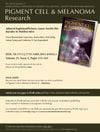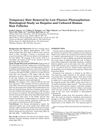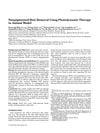Search
forLearn
4 / 4 resultslearn Thymosin Beta 4
learn Osteopontin
signaling protein that, when suppressed, may grow hair by reducing inflammation and stem cell loss
learn Low Level Laser Therapy
laser therapy for anti-inflammatory and likely insignificant hair regrowth effects
Research
5 / 1000+ resultsresearch Co-Factors of LIM Domains (Clims/Ldb/Nli) Regulate Corneal Homeostasis and Maintenance of Hair Follicle Stem Cells
Clim proteins are essential for maintaining healthy corneas and hair follicles.

research Adam10 Haploinsufficiency Causes Freckle-Like Macules in Hairless Mice
A mutation in the Adam10 gene causes freckle-like spots on Hairless mice.

research Temporary Hair Removal by Low Fluence Photoepilation: Histological Study on Biopsies and Cultured Human Hair Follicles
Low fluence photoepilation temporarily removes hair by targeting the hair follicle's pigmented area without severe damage.

research Nonpigmented Hair Removal Using Photodynamic Therapy in Animal Model
Photodynamic therapy can remove nonpigmented hair in mice and might work for humans.
research Dissecting the Impact of Chemotherapy on the Human Hair Follicle
Chemotherapy damages hair follicles, causing hair loss and other cellular changes.
Community Join
5 / 101 results
community Compressed part of research of theory of androgenic/anabolitic balance. AGA h-responders analytic. Theory of physio-metabolitic method of anti AGA treatment
The treatment for androgenetic alopecia involves using finasteride and minoxidil with intense exercise and cold exposure to boost metabolism and reduce androgenic effects, potentially leading to hair regrowth. This approach may activate biological pathways for improved hair and overall health.
community 2 years fin only 1mg/daily + 4 months of gradually introducing Dut 0.5mg/daily
A user experienced significant hair regrowth using finasteride 1 mg daily for two years and gradually introduced dutasteride 0.5 mg daily over four months. They reported no side effects and plan to switch fully to dutasteride due to its cost-effectiveness and potential effectiveness.

community Minoxidil Response Bottlenecks: Why Sulfation and Transport Matter (And Where Tretinoin Fits In)
Minoxidil's effectiveness is limited by the need for sulfation and proper transport to hair follicles, with tretinoin potentially enhancing its effects by promoting enzyme activity and keratinocyte differentiation. Tretinoin may improve minoxidil's response by boosting the expression of necessary enzymes and transporters.
community Topical Finasteride Doesn't Directly Reduce 5ar Enzyme on Scalp
Topical Finasteride doesn't directly reduce 5ar enzyme on scalp and has the same mechanism as oral, needing to go through the liver. Users debate the accuracy of this information and discuss various studies and experiences.
community So we have 20k dollars human like machines available but no new effective treatment for hairloss since finasteride :)
There have been no new effective hair loss treatments since finasteride, despite technological advancements. Current treatments include finasteride, minoxidil, and RU58841, with ongoing challenges and potential future solutions in research.